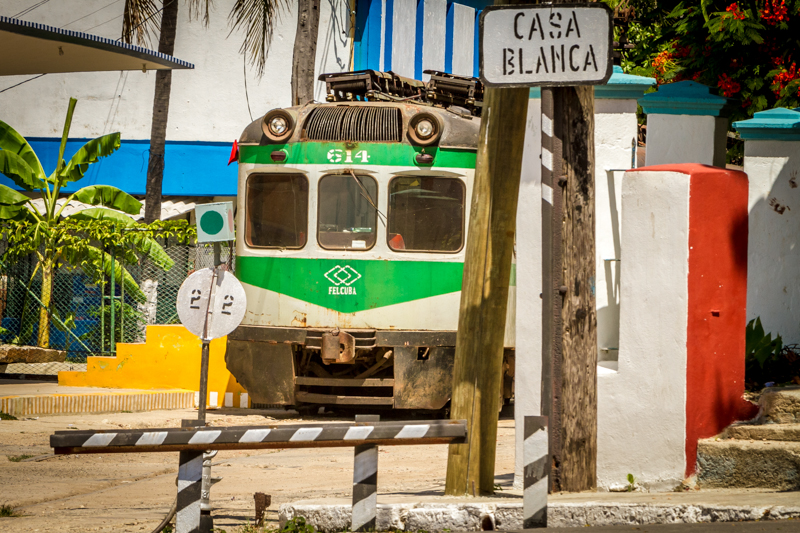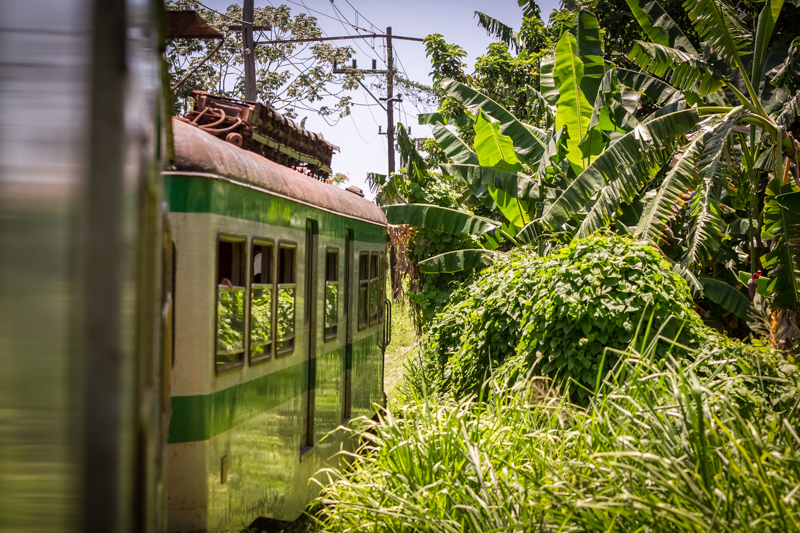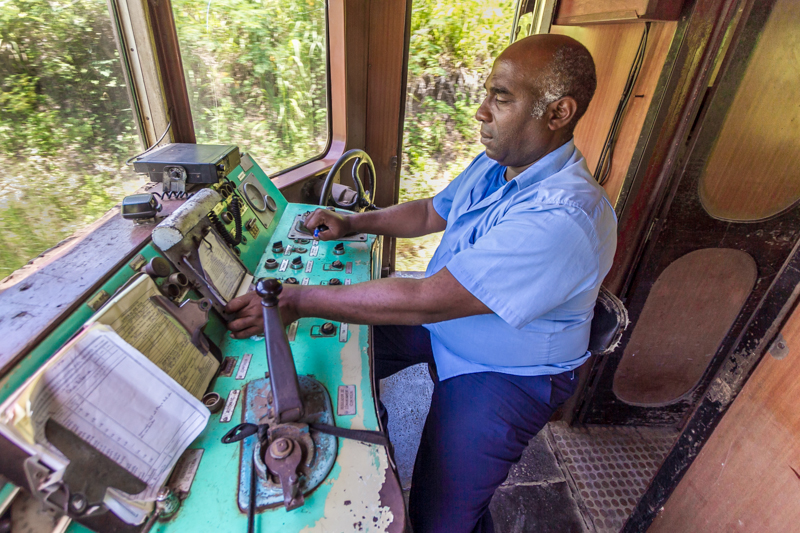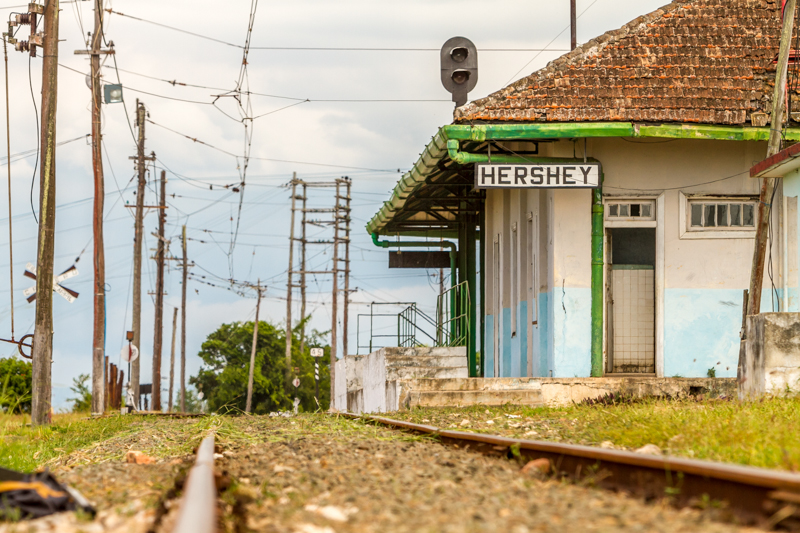The Hershey Train of Cuba
Photo Feature by Branson Quenzer

HAVANA TIMES — In Cuba there is always a backdrop to every story. That is both in its physical infrastructure and its systems and markets too. What was one way yesterday may be just the opposite the next.
With that in mind and due to multiple people telling me that the electric train is NOT the way to go because you might not ever get there, I was in pursuit of the legacy that was Hershey. And what is the fun in traveling if there is not a little glitch waiting to snag you up on. Well, mine wasn’t far off and it started from the get go.
“The electric train is very undependable,” the “schedule is erratic,” and “the old thing always breaks down,” were the most commonly mentioned drawbacks to taking the train. But this train, at least the rails, were laid before the revolution by a company that every person born within North America has grown up with, The Hershey Chocolate Company. What would camping be without S’mores and that square cut chocolate which snaps and fits so nicely between the crunchy crackers and the gooey marshmallows?
Of course there is the option of just renting a private car which will take you out there by road, but as the only electric train and the only one with a legacy, the journey is more important than the destination. Hailing a rust bucket of a cab which is a mix of car pieces and parts and often even boat motors as engines I decided for the early morning train which was supposed to leave at 8:30 a.m.

The cabbie said the same thing as most others suggesting that I might not even reach the city of Hershey, much less make it back. With each new opinion it seemed like this train may not even exist. We drove into the tunnel that brings you onto the other side of Havana Bay. The train sets off from the community of Casablanca.
Sputtering up on the train station you get your first glimpse of the rails, the electric lines and the cars that are backed up ready to head out. The cabbie said, “you go see if it is going today.” He was confident that he was going to make a couple more dollars taking me back to the proper side of the bay.
With a positive outlook I strode over to the ticket window and the clerk clicking fake fingernails tapped at the ticket counter as I approached. I asked for the 8:30 a.m. train and pointing to the schedule board above she said that that train no longer exists. I got up extra early in the morning to catch the first train and it was cancelled. The next train was in 4 hours and that meant my visit, if at all would be in the sweltering sun.

I asked the window clerk for a ticket on the next train at 12:30 and she looked at me like I was crazy. She mentioned that I could just get it when I came back, yet I had no idea how many people would be on the next train. By her expression it was not many, but what the hell did I know, and information I could get was scarce. I said, “see you later,” as she snickered thinking crazy guy wants to ride this busted train real bad.
I headed back to the Revolutionary Museum as it was the closest site that I had not checked off my list. Getting an “official” sense of another perspective of history is always enlightening both about the place you are and the place where you came from. There are so many veins in history and which ones surface more predominately than others are telling. In Cuba, the revolution was and to some extent still is everything. So getting a little history in before riding the pre-revolutionary and corporate tracks to the old sugar mill would give me some context.
The museum is worth the visit and a bust of Lincoln is prominently displayed on the inner staircase balcony of the central hall. A soda and hot dog from a stand outside the museum was a cheap meal before getting in a Russian Lada on my way back to the train depot.
I still had some time to kill and it was getting hot, so I went to the local shop to get some water for my upcoming train ride. And despite the two men sitting in there and the other Cubans trying to grab something for their ride they refused to sell anything. They opened the door more than once saying, we are closed. And that was it. They lit up their cigarettes and they were closed.

Well as a little warning, there is no other shop within walking distance where you can get a bottle of water or a soda
in Havana Casablanca. I ended up knocking on a few doors of houses and asked if I could just have a drink of water. They drink water from the tap, which they keep cool in the fridge. From then on out in Cuba I drank purely tap water, and never had a problem.
It was time for the train to leave and I get all excited and find a seat facing towards the direction of travel. I sit in a car that has a couple of older Cuban men, one leaning out the window finishing his cigarette. I thought they might provide for some good photography subjects on this historical ride. I know now why the ticketing agent was shaking her head at me. The metal seats with wooden slats for butt and back rests were not even close to full. And being that not all the seats even had back rests I don’t think it fills up very often. That could soon change with the changing political environment.
The 12:30 train pulls away and then breaks, 100 meters down the track. It went twice the length of itself and that is all she had. The seats are for what you would imagine were for prison guards from the 1950’s, and tickets are 1000% the cost for foreigners compared to what the Cubans pay. So it really broke my daily allowance putting a whole dollar fifty dent in my pocket.

Within a few minutes the engineers had got the current back and the train rolling again. A train attendant asked me to follow him to the front for better photos. I had no idea that he actually meant inside the conductors booth. A hefty, black and shiny bald headed man was the train’s captain, and with both doors open on either side of him he had the coolest seat on the train.
A gregarious man and curious too, we fall into something Cubans are very good at, intellectual and stimulating conversations. The train was from Barcelona he said. It did have the Catalan language and he said it was imported in the late 90’s. The original was American he said as he explained his understanding of the Hershey train and Cuban history. He had been driving the train for 15 years. We talked about politics, USA and its sugar company, then how Russia supported the sugar refinery. The USSR paid good prices for Cuban sugar he lamented. The train runs on 1200V and he motions “game over” if you touch the electric lines.
Coming around a corner he toots the train’s horn. I ask if I can do that. He smiles and gets up out of his chair as we are rolling through the Cuban countryside and says, hell you can drive. I sit in the conductor’s seat and give the train a good blasting whistle. I handed off my camera and let him snap away at me sitting proudly in his seat. Honestly, I really didn’t do much more than make the train whistle but then again I probably shouldn’t be twisting and pushing knobs and buttons on a train anyway, especially one with a rusty reputation.
A handshake, a friendly salute from me and it was back to my seat. At some point while I was driving the train a nice elderly couple sat in the seats opposite to mine. There was more talk about the US, USSR, Cuba and sugar. They better informed me that I could actually still walk around in the factory. The one hour ride turned into more than two, and the older gentleman who lived still another hour past where I was getting off pointed to some smoke stacks in the distance on the hill and said, that is the factory. I had reached Hershey.

The factory was not so much a factory as a wasteland with a skeleton of steel and 1920’s machinery rusting out, bending and collapsing on itself. The gaping hole in the chain-link fence with a sign saying “peligroso” or “danger” and don’t enter had a well-worn path leading right through it and so why can’t I go too? Nonsense sign… And after all that clanking on the train I thought a dead factory would be eerily quiet. Yet there were wrenching sounds of metal bending and breaking. Sugar it was not making but something was going on. It was not in the “building” and behind me a worker noticed me heading through the fence. He said nothing, but I didn’t want to take chances with another foreman or security guard who might just care.
So quickly skirting through the rubble and crude oil I found a set of stairs that were busted right out and rusted through. I have seen worse and climbed worse… no sign of fire so I figured if I treaded lightly then it will hold, at least one more time. Making my way towards the noise on the second level I see steal being cut. Sparks, green gas cylinders, and men with torches where cutting through steel amidst the mess of broken concrete, metal, bricks, etc. They were demolishing and dismantling the factory. Heavy machines would claw at the building breaking away the cement and tearing down the steal. Then it was manually cut with blow torches.
The factory had identical sides for its original intention of sugar production. It was horizontally symmetric. The furnaces, conveyer belts, gears, shafts, stacked 6 or 8 stories high and across stretched the length of the building. Exploring and keeping careful watch of each step I got to the next to the highest level before it all became all janky ladders and just a little to sketchy to get any higher. The machines are all stamped with production labels from the US’s industrial cities one being Birmingham Alabama of all places. What each machine did I am not sure but they are currently rusting and being scrapped. All 8 stories of them.

Heading out in the yard amongst the welders I see a man sitting off in the shade. As it turns out he was security and told me “no pictures.” A little late for that as I had already filled up one memory card. But he did clue me into what the adjacent factory remains where. It was a particle board factory. The Hershey Co. was using the waste of the sugar cane and creating particle board with it. An environmentally sweet tooth I suppose. Except I don’t really think the concept of environmentalism was around yet. It was all about money!
What is left of the factory I had seen and it was time for some food and drink. I spotted a limping worker and tracked him down as he was headed out the back of the demolition area. He was being released because of an injury. I asked if there was any food around and he said of course, follow me. And what do you know the nearest watering hole was a pizza joint. The gentleman even bought me a soda despite my insistence in buying him one. Again no bottled water and I slugged down a few glasses from tap water kept in the fridge. I ordered a pizza and enjoyed it with my soda in the shade in what once was a thriving town.
Back at the train station there was a gentleman selling drinks and sandwiches. We started up a chat; he was born before the revolution. He also did some fighting and military service which he said was mandatory when he was young. He spent three years in Angola, and was an electrical engineer for the military. The guy had some cool stories about world affairs and Cuban history. And of course because of the Russian influence he spent time in what is present day Ukraine. We both, simultaneously in Russian said, “I don’t understand Russian” and had a good laugh. He had been to the US and loved Fort Meyers FL and hated Miami. He has daughters there and goes to the US from time to time. He feels sad that his village and hometown of Hershey has gone through tough times after the factory closed. He said the younger generation must leave to find work.

Cuba is full of fascinating people, places and stories. The pre-revolution stories, the revolutionary times and the post revolution are all coming to a head with the next new wave of evolution. That is the US’s new and changing relationship. Maybe a new Hershey will be built. Maybe it will remain just a legacy. Today it is a graveyard of steel and crushed cement. One thing that is for certain, the people of Hershey will find a way as they have for the past 100 years to deal with change.
Visit the website of Branson Quenzer
Click on the thumbnails below to view all the photos in this gallery. On your PC or laptop, you can use the directional arrows on the keyboard to move within the gallery. On cell phones use the keys on the screen.























Did Hurricane Irma in Fall 2017 damage the line with washouts and pole damage? I have heard the entire electric line has not run since? Will it be repaired?
Great story! I’m going in March, would love to have a similar experience.
Since you’ve been there, would you still recommend getting off at Hershy, or exploring another town on the way?
Also, was there a time table for the return train? Thanks again for writing and sharing.
Thanks… Hope to see you on the train someday!
Great story! I took and drove the Hershey Train from Hershey east 20 km to Canasi while staying at a Jibacoa beach resort in late March. Fare was 80 cents. We had a brief 1200 vdc pantograph runner breakdown and repair too. Puppies and chickens on board, as well as a young couple from Vancouver. Lots of stops at road crossings and tiny stations.
Sad to see the Hershey refinery being dismantled as are many others in Cuba, thanks to high fructose corn sugar replacing sugar cane sucrose worldwide. I believe the particle board factory used to be in nearby Santa Cruz Del Norte, about 3 km north near the ocean, and the Havana Club dark rum factory.
Hopefully this 1920’s scenic and historic electric interurban railway to Matanzas will survive another century, accommodating both locals and tourists in harmony. There were plans displayed in Hershey for possible Casablanca improvements and tourist highlights and attractions along the line. 100th anniversary coming.
The story and pictures are full of atmosphere, yes this is the real Cuba, I am if the train stopped every 1000 metres a new story would evolve. Cuba DO NOT LOSE THIS MAGIC.
Bob,
Sorry to invade in your fishing hole! But thanks for sharing it for one day with me. Good places can be spoiled by poor development strategies. But lets hope the people get a piece of the pie to improve their lives.
On the way back I took the boat! Not only is it cheaper it is more beautiful too!
Damn, you have to go tell the world about the Hershey train and town of Hershey. I have always considered the whole Hershey adventure as sort of my own
personal secret fishing hole. I tell close friends and
family but never the public out there on the internet. I have ridden that train about 10 times, always up front, and often driving it as I know most of the crew. I read of many people I know in your story there, including the guy who sells food at the Hershey train station.
BTW, it is much quicker and cheaper (20 centavos Cubano, about a penny) to take the ferry across Havana harbor rather than a taxi the long way around through the tunnel.